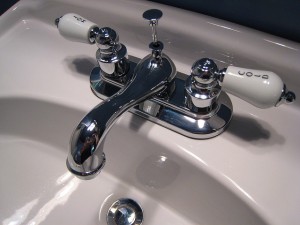Worsening drought conditions demand the attention of all Californians. Whether you are a homebuyer or a seller, water conservation will increasingly be a part of your real estate discussions — and decisions.
 If you are a buyer, you will save money (and headaches down the road) by checking prospective homes for water-efficient appliances and low-flow toilets and making sure the plumbing is up to date and faucets don’t leak.
If you are a buyer, you will save money (and headaches down the road) by checking prospective homes for water-efficient appliances and low-flow toilets and making sure the plumbing is up to date and faucets don’t leak.
For sellers, water-conserving improvements are a sign to prospective buyers that your home has been well-maintained and kept up to date with modern housing standards.
Drought-resistant landscaping is another key factor in conservation efforts at home, and we will discuss the subject in future posts. Today, however, we focus on efforts inside the home to help all of us cope with the very real threat of shrinking water supplies in the Bay Area and across California.
Toilets are by far the main source of water use in homes, accounting for nearly 30 percent of indoor water usage. Older, inefficient toilets use as much as six gallons per flush, while newer models that meet current federal standards use 1.6 gallons per flush. The very latest models, however, use 1.28 gallons per flush or less while still providing equal or superior performance.
The U.S. Environmental Protection Agency estimates that replacing old, inefficient toilets with one of the newest models reduces water used for toilets by 20 to 60 percent for the average family, saving nearly 13,000 gallons of water per home every year. That could add up to more than $110 per year in water costs.
These extremely efficient toilets carry the EPA’s WaterSense label, which identifies a wide range of high-performance, water-efficient appliances, fixtures, water systems, and accessories, including shower heads, faucets, and water softeners. Other energy- and water-efficient appliances, such as dishwashers, clothes washers, and water heaters, can be identified by the EPA’s Energy Star label. For more information from the EPA on conserving water, visit the agency’s Green Homes website.
Did we mention that there are dozens of rebates and free products available to Californians to promote water conservation?
The incentives are sponsored by state and local agencies. The Santa Clara Valley Water District, for example, offers free shower heads and faucet aerators, as well as toilet flappers and shower timers. In Santa Rosa, homeowners can get a $25 rebate on a high-efficiency clothes washer and a $100 rebate on a recirculating hot-water pump. San Francisco residents can recieve a $150 rebate on an Energy Star clothes washer.
The rebates and free products are scattered across two websites. To see what is available in your community, visit the EPA’s WaterSense Rebate Finder page, as well as the Find Your Local Water Agency page on the statewide Save Our Water website.
The Save Our Water site is a partnership between the Association of California Water Agencies and the California Department of Water Resources, and it presents updated news on California’s drought, as well as tips for conserving water indoors and outdoors. Another useful website is that of H2ouse.org, hosted by the California Urban Water Conservation Council, with tips for conserving water both indoors and outdoors.
Additionally, most Bay Area water agencies offer free water-use inspections. An expert will come to your home to check for leaks and offer tips on how to save water and lower your bill.
(Photo: Flickr/Brian Noe)
